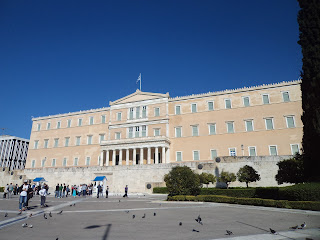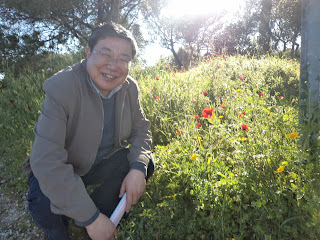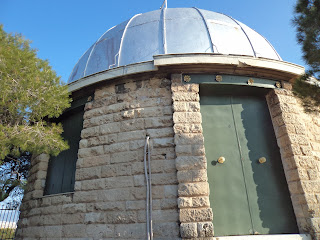THE PNYX
The
operation of the ecclesia tou Demou (citizens' assembly) on the Pnyx hill or hill of Nymphes dates
to the end of archaic period 500 B.C. and was connected with the political
changes implemented by Cleisthenes. Its function remained the same until the
late 400 B.C. when the activities were gradually transferred to the Theater of
Dionysos (Acropolis South Slope), which resulted in its losing its primary
political significance; This may explain the fact that it is not mentioned by
the traveler Pausanias, who visited Athens in the 200 A.D.
The
first to conduct excavations in the area was the Englishman George, Earl of
Aberdeen (1803), who uncovered the Bema (speakers' platform) of the Pnyx and
the niches of the sanctuary of Zeus
Hypsistos. In 1835, the archaeologist K.Pittakis found the inscription marking
the boundary of the Pnyx, HOROS PYKNOS ("Boundary of the Pnyx").
During
the period when it was in operation, the Pnyx presents three building phases:
In phase
"Pnyx I" 6th-5th c .B.C) at theatrical space with the speaker's
platform set at the north was created. This Pnyx, whose capacity is reckoned at
5,000 people, is the Pnyx of Aristophanes, and it was from its speaker's
platform that Miltiades, Themistocles, Aristides, and Pericles spoke.
In phase "Pnyx phase II" (late 5th c.B.C.) the site was enlarged with the cavea of the amphitheater a retaining wall was built on the north, and two staircases led from the northeast to the cavea. In this phase, which is connected with the rule of the Thirty Tyrans (404-403 BC), the position of the speaker's platform changed orientation and was reset towards the southwest. Pnyx II had a capacity of 6.000 people. The orators Demosthenes, Aeschines and Isocrates spoke from the platform.
In phase "Pnyx III" (late 4th c BC), during the orator Lycurgus - the phase which is visible today - the orientation of the speaker's platform remained to the southwest, but the cavea was expanded with construction of a new monumental retaining wall. The capacity of the cavea, with a depth of 70m and a diameter of 120 m, is estimated to have reached 13,500. The Bema of the orators of phase III, the famous Lithos preserved intact, is the most imposing ancient remain on the site. Carved into the natural bedrock, it is 9 m long on its facade, and has three steps (for a total height of 1.10 m)
The ambitious plan of remodeling of Pnyx III included the creation of the East and West stoas to protect those gathered for assemblies. These we never completed, either because of the theater of Dionysos was finished during the same period and assemblies were transferred there, or because the need to build the Diateichisma arose.
In phase "Pnyx phase II" (late 5th c.B.C.) the site was enlarged with the cavea of the amphitheater a retaining wall was built on the north, and two staircases led from the northeast to the cavea. In this phase, which is connected with the rule of the Thirty Tyrans (404-403 BC), the position of the speaker's platform changed orientation and was reset towards the southwest. Pnyx II had a capacity of 6.000 people. The orators Demosthenes, Aeschines and Isocrates spoke from the platform.
In phase "Pnyx III" (late 4th c BC), during the orator Lycurgus - the phase which is visible today - the orientation of the speaker's platform remained to the southwest, but the cavea was expanded with construction of a new monumental retaining wall. The capacity of the cavea, with a depth of 70m and a diameter of 120 m, is estimated to have reached 13,500. The Bema of the orators of phase III, the famous Lithos preserved intact, is the most imposing ancient remain on the site. Carved into the natural bedrock, it is 9 m long on its facade, and has three steps (for a total height of 1.10 m)
The ambitious plan of remodeling of Pnyx III included the creation of the East and West stoas to protect those gathered for assemblies. These we never completed, either because of the theater of Dionysos was finished during the same period and assemblies were transferred there, or because the need to build the Diateichisma arose.
THE PATH TOWARDS ACROPOLIS AND TO PNYX
THE PATH TO PNYX






















































































































Δεν υπάρχουν σχόλια:
Δημοσίευση σχολίου
Σημείωση: Μόνο ένα μέλος αυτού του ιστολογίου μπορεί να αναρτήσει σχόλιο.